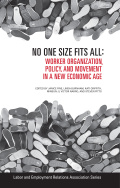No One Size Fits All, Worker Organization, Policy, and Movement in a New Economic Age
Janice Fine, Linda Burnham, Kati Griffith, Minsun Ji, Victor Narro, Steven Pitts
December 15, 2018
Economic Justice, Publications, The Future of Work, Working Class History, Book/Edited VolumeSummary
Workers and their organizations are facing enormous obstacles today. Corporations wield immense power, not only in the marketplace but also in politics, which has, for many years, effectively blocked the updating of antiquated laws governing labor relations. Instead, unions have been subjected to a steady onslaught of attacks at the state level and growing hostility from the US Supreme Court. They have all but lost basic protections that the legal system once provided—making organizing, bargaining, and striking increasingly difficult. Black workers continue to face a decades-long job crisis characterized by disproportionate unemployment (compared with White workers) and poor job quality. Immigrant workers of all statuses feel the threat of exclusionary immigration policies and heightened xenophobic rhetoric coming from the top echelons of the US government.
Similar to worker organizing in the United States before the New Deal contract, organizations in the late 20th and early 21st centuries have been scrambling to find leverage within an increasingly hostile economic, political, and legal environment. Despite formidable obstacles, this volume shows that vibrant, creative experimentation has never ceased. In lieu of new federal regulation, public and private sector national unions and local affiliates have been actively trying out new approaches that pair organizing with mechanisms that support bargaining. They have doubled down on electoral politics and creative policy fights to raise standards and facilitate organizing, with an unprecedented focus on low-wage workers. They have forged closer, more equal partnerships with community organizations than ever before. Still much more work needs to be done.
New organizational models are also emergent. These experiments, which include worker centers and what some refer to as "alt labor" groups, diverge from traditional labor unions in a number of ways. They aim to represent workers and their workplace interests but do not typically work within the New Deal collective bargaining construct regulated by the government.


